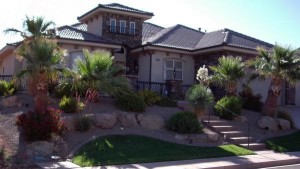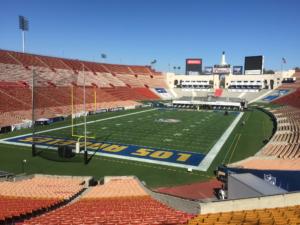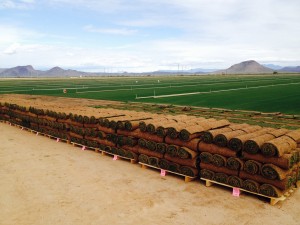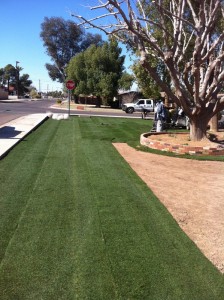Aug
Late Summer Sod Tips for California and Arizona Lawns
Summer Sod Tips for California and Arizona Lawns
Summer is wrapping up, the kids are heading back to school, and I’m sure you’re ready to come out of hibernation. While the summer heat is far from over in Arizona and California, it’s going to become tolerable outside. With the slightly cooler mornings it’s time to get back outside and get your lawn ready for fall. Most people start thinking about overseeding their California and Arizona sod in September, but ideally you wouldn’t start the process until October when nighttime temperatures get into the 60’s. Between now and then there are some important steps you need to do to get your lawn ready and to save some headaches down the road.
Between May and September you’ll probably notice your lawn has grown at twice the rate it does during the winter months. Warm season grasses love the warm, wet weather. Most people thought the hot weather would keep the grass from growing well, but remember warm season grasses optimal growing temperatures are between 90-105 degrees. During this season any of your weaker areas should have filled in with the warm season grasses runners. These spots can be slow to fill in during the dry, hot days but as soon as the humidity kicks in the grass really takes off. If you still have large open spots I would suggest picking up a few rolls of sod and patching them prior to overseed. You don’t want to seed directly into the soil.
During the summer months you’re getting lots of new growth on the grass plant and you need to help it thrive. The best way to do this is to thin out the top growth by using a verticut or power rake. Most people only use one during the overseed season but it’s a vital part of promoting new growth during the summer months. When you get too much top growth the grass will get clumpy and keep your new plants from growing. A verticut or power rake will open the turf canopy and thin out the grass plant. Doing so will promote new plant growth. This will also allow you to mow your lawn shorter without scalping. Set the power rake or verticut about halfway down and run over the entire lawn. You can easily mow or rake up the material. Keep in mind that by thinning it now you will save yourself hours of labor during overseed. If you wait until overseed to thin your lawn you may need to repeat this process several times.
For the next month you don’t want to promote top growth unless you don’t plan on overseeding this fall. The more material you have, the more material you will need to remove during overseed. I like to stick to slow release nitrogen products or products that will promote root growth during late summer. There are lots blends that will work but phosphorus and potassium will help your roots at this time of the year.
It’s still too hot to really cut back your water but during the wet periods you can let the lawn stress before you turn the irrigation system back on. Let the lawn go until you see some bluish grey spots appearing in the lawn. These areas aren’t dying but they are stressed. When you see these spots you know it’s time to water again. You can start to back your water down in mid-September when the nights cool off a little more.
If you’ve had persistent weed issues during the winter months you can apply Prodiamine. One product that a lot of people use is Barricade. This must be used 7 weeks prior to overseed. Keep in mind you must wait 7 weeks after you spray this product before you overseed. For the first two weeks of overseed you will need to keep the seed a little more wet than usual so the roots of the new plant can break through the Barricade layer. If you sprayed this week it would have you overseeding in the middle of October which is perfect. The best overseeding period is typically from October 7th-October 31st. Any time you seed during this time frame you will have very little competition from the underlying warm season grass. If you go earlier be prepared for the warm season grass to come back and be actively growing while you’re watering the ryegrass seed.
One way to keep the warm season grass in check is through applications of plant growth regulators such as Trinexapacethyl. One such product that many use is Primo. This can be applied 5-7 days prior to overseeding at .5 oz/1000 SF and right after the first mowing at .35 oz/1000 SF. If you seed during the normal window in October you can skip this step unless you have a very lush, over fertilized lawn going into fall. This is not an endorsement of these products but a generic list of products you can try.
The final thing you can do is mow a little lower for the next few weeks and reduce the turf density. Right before overseed I will tell you to let the grass grow up about 30-40% prior to scalping but you have over a month until you need to worry about it.
Remember when you start to see seed in the stores you want to find a perennial ryegrass that is weed free, and has a high germination rate. Many of the products you will see will be cheap in cost and won’t provide you with a dark green lawn during overseed. I will put out overseed instructions in September as we get closer to the season.
If you have any questions, please hit the “Ask Jay” button at the top right of this page.
Till next time,
Jay
Comments Off on Late Summer Sod Tips for California and Arizona Lawns
Jul
Summer Maintenance for Your California and Arizona Sod
For those of us in the desert areas we’re just about to monsoon season. For many this is a welcome relief from the heat and your lawn agrees. While warm season grasses love hot weather for growing, they thrive when there is humidity in the air. I realize the desert regions aren’t like the south with 90% humidity but 105 degrees and 25% humidity are pretty nice for a warm season lawn. With humidity comes a little maintenance. Similar to trimming your trees prior to heavy monsoon winds, grass does better when it is thinned out. Today I’m going to give you a couple different ways to manage your warm season lawn.
Every lawn has new growth coming from the crown down below looking to get to the surface. Often times its blocked by the older leaves that don’t allow it to grow through and flourish. What do you do to establish your new growth? For the residential market its easy to rent a power rake from your local equipment rental store or Home Depot. This machine opens up the turf canopy and thins out the plant and thatch layer. Be careful not to set this too low and dig out too much thatch. It is beneficial to have between ½” and ¾” of thatch. Anymore than that keeps water and air from reaching the soil and can be a breeding ground for insects and possible disease. This machine will help you remove layers of dead grass and roots allowing for better water infiltration.
One sign your lawn has too much thatch is needing to use more water than normal. Dig out a piece of your lawn with a shovel and measure the thatch layer. Thatch is the layer between the soil and crown of the plant. This will be very easy to see if you dig out a shovel sized sample.
Another common practice is aeration. The nice thing about doing this during the humid time of the year is the ground doesn’t lose moisture quite as quickly as it does in June when the weather is hot and dry. Knowing when to aerify your lawn can be a little bit tricky but a general rule of thumb is to do so every other year. This will prevent soil compaction and allow your roots to grow deeper into the soil.
When a soil is compacted the roots will often stay in the top few inches of the soil resulting in a plant that isn’t as heat or cold tolerant as one with a solid root system. Often times people realize their lawn is compacted when water is running off the soil surface. No one wants to waste water and its also not healthy for the plant not to be able to take up water from the soil.
Having a company come out and aerify your lawn is quick and easy. The plugs don’t need to be removed from the surface and the holes don’t need to be filled in. You can simply mow or mulch up the plugs next time you mow the lawn. Be a little careful as a newly aerified lawn will dry out faster than normal for the first few days but it will quickly fill in the gaps and return to normal. Aerifying is an essential practice to maintaining a great lawn and saving water.
- Quick top growth or grow in to cover voids – ammonium sulfate 21-0-0 at 5 pounds per 1000 SF.
- Maintenance fertilizer – 21-7-14 or 15-15-15 every 4-5 weeks during the growing season
- Pasaplum recovery – Kelplex or half rate of 15-15-15
- Starter Fertilizer – Soil Burst 4-4-2
If you have any questions pleased let me know.
Jay
Comments Off on Summer Maintenance for Your California and Arizona SodSep
Pre-Overseeding Tips for Your Lawn
I would like to start by congratulating everyone on making through another California and Arizona summer. I know we still have a couple months of triple digit temperatures, but the worst should be behind us at this point. As we move into September our morning temperatures will start to feel less painful, but remember your warm season grass is loving this weather–especially your California and Arizona sod. I have started to field questions regarding fall overseeding and I want to tell you to hit the brakes. Don’t just tap the brakes, slam on the brakes. You will see ryegrass hit the stores in the next week but walk away or buy it and sit on it until temperatures really drop. Today I want to discuss prep for the fall, and how to get your grass ready to overseed. This won’t be a tutorial on how to overseed, but instead some pointers of what to do before you overseed.
Comments Off on Pre-Overseeding Tips for Your LawnMar
Seashore Paspaulum and Spring Transition for Your Warm Season Lawn
Arizona Diamondbacks
As many of you know BOBSod has been the turf of choice for the Diamondbacks since its conception in 1998, but this year we made a change. The Diamondbacks grounds crew experimented with a few different varieties over the last year and they decided to make the change to the environmentally friendly Platinum TE seashore paspalum. While the BOBSod is still performing at an extremely high level, a shift was made to go with a grass that could be installed without overseed in early March. For those not familiar with paspalum one of its best attributes is its shorter dormancy period. Paspalum can handle temperatures that drop into the 40’s at night before losing color while bermudagrasses will start to lose color in the 50’s. This often leads to a 3+ weeks longer season in the fall and can often green up a few weeks earlier in the spring.
Having the roof over Chase Field provides a lot shade during the spring transition and can really extend the life of the ryegrass. As you probably have learned from your bermudagrass lawns over the years shade will take out your grass over time. Since the ryegrass can live longer inside the stadium, it makes for a longer transition. With this in mind the groundskeeper decided to make the choice to use a non overseeded grass and avoid any transition.
Comments Off on Seashore Paspaulum and Spring Transition for Your Warm Season Lawn
Jan
Weeds and Your Arizona and California Lawns.
We haven’t had a very wet winter but with the recent rains we’re going to start to see the emergence of some winter annual weeds. The good news is the weeds that are starting to emerge are easy to control.
There are some types such as annual bluegrass, crabgrass, and nutsedge that are a little more complicated but timing pre-emergent herbicide applications can save you a lot of headaches with weed control. In this blog I will go over various weeds and some ways to control them as well as discuss herbicide timing. Weed control management is a function of several different factors but some of the things you can do to keep your lawn healthy are maintain the proper mowing height, not overwatering, fertilize monthly, and aerate the turf when the soil becomes compacted. These items right here can be the difference between weeds slowly emerging in your lawn and taking over your lawn. A healthy lawn will push out weeds and keep them to a minimum. If you have very few weeds emerge during the year chemical applications are usually unnecessary and weeds can be pulled by hand as they appear.
Comments Off on Weeds and Your Arizona and California Lawns.Apr
Spring Lawn Transition Questions Answered for California and Arizona Sod!
Spring has sprung and your warm season sod might need a little help with the transition in California and Arizona. Mr. Wise Grass is here to help! Check out his latest video for tips on how to keep your lawn looking the best in the neighborhood!
IMPORTANT! FOLLOW THESE STEPS FOR A BEAUTIFUL, LUSH LAWN:
Step By Step Transitioning for California and Arizona Sod
Comments Off on Spring Lawn Transition Questions Answered for California and Arizona Sod!May
Soil Prep/Lawn Establishment
With the rising temperatures we have quickly entered the best time of the year to plant sod. I’m sure a few of you just read the first sentence and thought that I was crazy since we’re hitting 105-110 degrees most days. Warm season turf is so well adapted to this type of weather that establishing a lawn during the summer is a simple process with the right prep work and follow up. I’m going to outline some simple cost effective steps for those looking to put in a lawn this summer.
Living in the desert we all know that water is scarce so we want to do our best to preserve it and not overuse it. One of the best water saving tips is putting in an automatic sprinkler system. Before I proceed I will tell you that I don’t recommend putting in a new lawn without one. A good sprinkler system will allow you to put out the correct amount of water in a given period of time and will help eliminate waste.
Setting up a manual sprinkler or hose is inefficient, time consuming, and most of all it is very tough to gauge the amount of water you actually put out. Before putting in an irrigation system you should by a small gauge to check your homes water pressure. Knowing how much water pressure you have will determine how many sprinklers can be on each valve. Depending on the area you will be watering you may need a couple to several valves to correctly operate your irrigation system. Most sprinkler systems are set up with a valve that controls the drip lines to the plants and then a valve for each section of the turf. A home with 1000 square feet of turf will typically have two valves to control the lawn. If you have very low water pressure you will probably need to add a third valve so less sprinklers are running at one time.
Comments Off on Soil Prep/Lawn Establishment
Feb
Pre Emergent Weed Control/Watering/Fertilizer
Installing Fresh BOBSod into a Home in Casa Grande
In my last blog I talked about a few weeds that are starting to appear in your lawn that are perennial problems. This week I want to talk about getting down a pre-emergent herbicide on your lawn before all the spring and summer annuals start to show their faces. Weather obviously plays a key role in everything we do concerning turfgrass so it is important to get the timing right. Read the rest of this entry »
Comments Off on Pre Emergent Weed Control/Watering/Fertilizer







